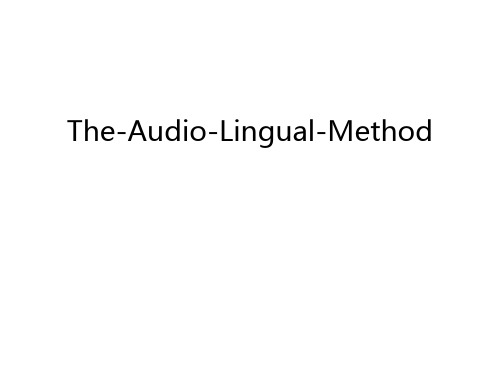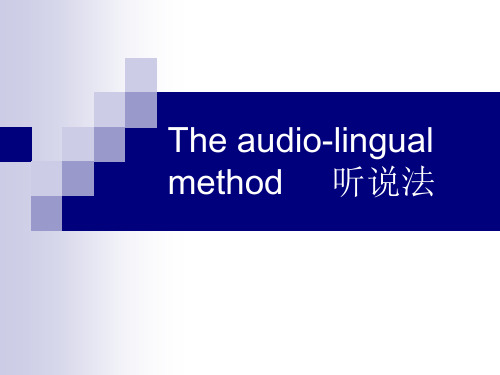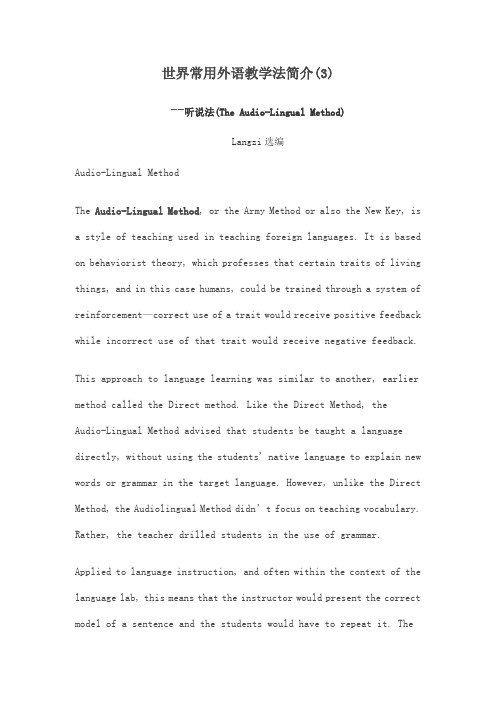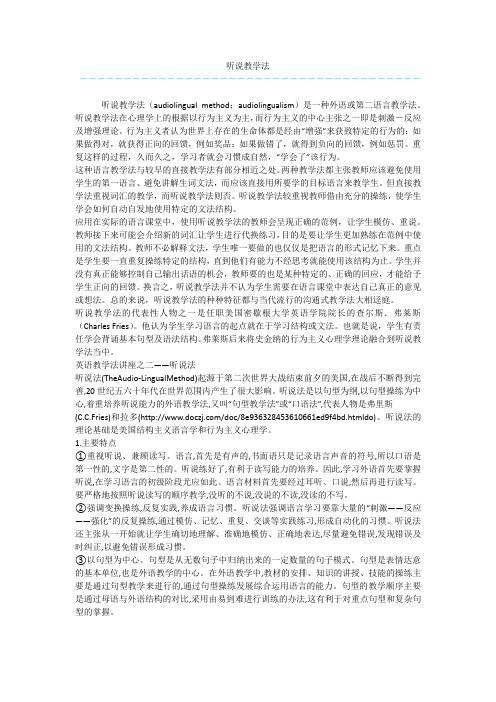英语教学法 听说法The Audiolingual Method
The-Audio-Lingual-Method教案资料

理论基础
• 结构主义语言学
• 强调第二语言教学要从口语开始,从说话开 始,通过掌握语言结构学会目的语言。认为 语言首先是说的话,所有的人在学会阅读之 前都是先学会说话的,文字是话语的表现形 式。
• 行为主义心理学
• 认为言语行为是通过刺激与反应的联结并加 以强化而形成习惯,强调第二语言教学要通 过大量的模仿和反复操练养成新的语言习惯 。
c) Emphasis on certain practice techniques: mimicry, memorization and pattern drills (强调模仿、记忆和句 型操练)
d) Discouraging the use of the mother tongue in the classroom(在课堂教学中避 免使用母语)
It uses dialogues as the main form of language presentation and drills as the main training techniques.
Mother tongue is discouraged in the classroom.
Historical background
Practical applications
• Family Album U.S.A. • English 900
Thank You!
此课件下载可自行编辑修改,仅供参考! 感谢您的支持,我们努力做得更好!谢谢
3
背景
听说法于20世纪40年代在美国产生。 第二次世界大战爆发后,美国军队为 在短期内培养大批掌握外语口语能力 的军人,采取一系列的措施和手段强 化训练士兵的听说能力,听说法便应 运而生。战后,该法被推广应用到学 校外语教学中,并在20世纪五六十年 代风行美国和s
The audio-lingual method

⊙Listen
to the tape, and imitate the dialogue.
Background
●1940s Word Ward Training Program (ASTP) →success
Definition
The approach was theoretically underpinned by structural linguistics, a movement in linguistics that focused on the phonemic(音 素的), morphological(语形学的) and syntactic(造句法的) systems underlying the grammar of a given language.
Response behavior
Characteristics
The automatic production and comprehension of utterances can be learned by inducing the student to learn. Language skills are learned more effectively if the items to be learned in the target language. Analogy(类推) provides a better foundation for language learning than analysis. Inductive teaching(归纳法) of grammar is preferred(首选). Teaching a language involves teaching aspects of the native cultural system.
4 The Audiolingual Method听说法

• Learners studied 10 hours a day, 6 days a week, with 15 hours of drill with native speakers and 30 hours of private study over 2-3 six week sessions.
The starting point was grammar or “structure” of language: its basic
sentence patterns and grammatical structures.
Systematic attention on pronunciation and sentence patterns
Method and the Aural-oral Approach, and add their insights from structural linguistic theory, contrastive analysis and behaviorist psychology. All these led to the Audiolingual Method.
Background: New demand
The entry of the US into WWII put forward an urgent need to train
military staff as interpreters, translators or code-room assistants.
The Audiolingual Method: Emergence
The approach developed by Fries and others was known as the Oral
世界常用外语教学法简介

世界常用外语教学法简介(3)--听说法(The Audio-Lingual Method)Langzi选编Audio-Lingual MethodThe Audio-Lingual Method, or the Army Method or also the New Key, is a style of teaching used in teaching foreign languages. It is based on behaviorist theory, which professes that certain traits of living things, and in this case humans, could be trained through a system of reinforcement—correct use of a trait would receive positive feedback while incorrect use of that trait would receive negative feedback. This approach to language learning was similar to another, earlier method called the Direct method. Like the Direct Method, theAudio-Lingual Method advised that students be taught a language directly, without using the students' native language to explain new words or grammar in the target language. However, unlike the Direct Method, the Audiolingual Method didn’t focus on teaching vocabulary. Rather, the teacher drilled students in the use of grammar.Applied to language instruction, and often within the context of the language lab, this means that the instructor would present the correct model of a sentence and the students would have to repeat it. Theteacher would then continue by presenting new words for the students to sample in the same structure. In audio-lingualism, there is no explicit grammar instruction—everything is simply memorized in form. The idea is for the students to practice the particular construct until they can use it spontaneously. In this manner, the lessons are built on static drills in which the students have little or no control on their own output; the teacher is expecting a particular response and not providing that will result in a student receiving negative feedback. This type of activity, for the foundation of language learning, is in direct opposition with communicative language teaching.Charles Fries, the director of the English Language Institute at the University of Michigan, the first of its kind in the United States, believed that learning structure, or grammar was the starting point for the s tudent. In other words, it was the students’ job to orally recite the basic sentence patterns and grammatical structures. The students were only given “enough vocabulary to make such drills possible.” (Richards, J.C. et-al. 1986). Fries later included principles for behavioural psychology, as developed by B.F. Skinner, into this method.Drills and pattern practice are typical of the Audiolingual method. (Richards, J.C. et-al. 1986) These includeRepetition : where the student repeats an utterance as soon as he hears itInflection : Where one word in a sentence appears in another form when repeatedReplacement : Where one word is replaced by anotherRestatement : The student re-phrases an utteranceExamplesInflection : Teacher : I ate the sandwich. Student : I ate the sandwiches.Replacement : Teacher : He bought the car for half-price. Student : He bought it for half-price.Restatement : Teacher : Tell me not to shave so often. Student : Don't shave so often!The following example illustrates how more than one sort of drill can be incorporated into one practice session :“Teacher: There's a cup on the table ... repeatStudents: There's a cup on the tableTeacher: SpoonStudents: There's a spoon on the tableTeacher: BookStudents: There's a book on the tableTeacher: On the chairStudents: There's a book on the chairetc.”Historical RootsThe Audio-lingual method is the product of three historical circumstances. For its views on language, audiolingualism drew on the work of American linguists such as Leonard Bloomfield. The prime concern of American Linguistics at the early decades of the 20th century had been to document all the indigenous languages spoken in the USA. However, because of the dearth of trained native teachers who would provide a theoretical description of the native languages, linguists had to rely on observation. For the same reason, a strong focus on oral language was developed. At the same time, behaviourist psychologists such as B.F. Skinner were forming the belief that all behaviour (including language) was learnt through repetition and positive or negative reinforcement. The third factor that enabled the birth of the Audio-lingual method was the outbreak of World War II, which created the need to post large number of American servicemen all over the world. It was therefore necessary to provide these soldiers with at least basic verbal communication skills. Unsurprisingly, thenew method relied on the prevailing scientific methods of the time, observation and repetition, which were also admirably suited to teaching en masse. Because of the influence of the military, early versions of the audio-lingualism came to be known as the “army method.”.In PracticeAs mentioned, lessons in the classroom focus on the correct imitation of the teacher by the students. Not only are the students expected to produce the correct output, but attention is also paid to correct pronunciation. Although correct grammar is expected in usage, no explicit grammatical instruction is given. Furthermore, the target language is the only language to be used in the classroom. Modern day implementations are more lax on this last requirement.Fall from popularityIn the late 1950s, the theoretical underpinnings of the method were questioned by linguists such as Noam Chomsky, who pointed out the limitations of structural linguistics. The relevance of behaviorist psychology to language learning was also questioned, most famously by Chomsky's review of B.F. Skinne's Verbal Behavior in 1959. The audio-lingual method was thus deprived of its scientific credibilityand it was only a matter of time before the effectiveness of the method itself was questioned.In 1964, Wilga Rivers released a critique of the method in her book, “The Psychologist and the Foreign Language Teacher.“ Subseq uent research by others, inspired by her book, produced results which showed explicit grammatical instruction in the mother language to be more productive. These developments, coupled with the emergence of humanist pedagogy led to a rapid decline in the popularity of audiolingualism. Philip Smith's study from 1965-1969, termed the Pennsylvania Project, provided significant proof that audio-lingual methods were less effective than a more traditional cognitive approach involving the learner's first language.TodayDespite being discredited as an effective teaching methodology in 1970, audio-lingualism continues to be used today, although it is typically not used as the foundation of a course, but rather, has been relegated to use in individual lessons. As it continues to be used, it also continues to gain criticism, as Jeremy Harmer notes, “Audio-lingual methodology seems to banish all forms of language processing that help students sort out new language information in their own minds.” Asthis type of lesson is very teacher centered, it is a popular methodology for both teachers and students, perhaps for several reasons but in particular, because the input and output is restricted and both parties know what to expect.Manifestations in Popular CultureThe fact that audio-lingualism continues to manifest itself in the classroom is reflected in popular culture. Films often depict one of the most well-known aspects of audio-lingualism : the repetition drill. In South Park Episode #172, Cartman applies the repetition drill while teaching a class of high school students. In Mad Max Beyond Thunderdome, an LP record of a French lesson instructs a pair of obliging children to 'repeat' short phrases in French and then in English.听说法(The Audio-Lingual Method)本世纪40年代开始,结构语言学、数学语言学、心理语言学、控制论、行为主义心理学等相互渗透的学科得到发展;外语教学日益依赖现代技术;各国教学法家竞相实验新的教学法体系。
英语教学法之AudiolingualMethod(听说法)

英语教学法之AudiolingualMethod(听说法)Definition of Audio-lingual Method (American)a method of foreign or second Language teaching which emphasizes the teaching of speaking and listening before reading and writing; mother tongue is discouraged in the classroom.Historical and social backgroundI Prompted by WWIIThe Audio-lingual Method is in origin mainly American. The Audio-lingual Method was developed in the U.S. during the Second World War. At that time, the U.S. government found it a great necessity to set up a special language training program to supply the war with language personnel who could speak fluently in German, French, Italian, Chinese and other languages. The objectives of the army program were for students to attain conversational proficiency in a variety of foreign languages.The "methodology" of the Army Method was derived form the intensity of contact with L2 rather than from any well-developed methodological basis.The A udiolingua l Method is also known as the “informant method”, since it used a native speaker of the language, the informant, and a linguist.The informant served as a source of language for imitation, and the linguist supervised the learning experience.II Academic PromotionIn 1941 the first English Language Institute in the U.S. was established in the University of Michigan. The director of the institute was Charles Fries, who applied the principles of structural linguistics to LT. The result is an approach whichadvocated aural training first, then pronunciation training, followed by speaking, reading and writing.The emergence of the Audio-lingual Method resulted from the increased attention to FLT in the U.S. towards the end of the 1950s.III Political PromotionThe need for a radical change and rethinking of FLTM was promoted by the launching of the 1st Russian satellite i n 1957.The US government acknowledged the need for a more intensive effort to teach a foreign language in order to prevent American from becoming isolated from scientific advances made in other countries.IV the OutcomeThis need made LT specialists set about developing a method that was applicable to conditions in U.S. college and university classrooms. They draw on the earlier experiences of the army programmes and the Aural-Oral or Structural Approach developed by Fries and his colleagues, adding insights taken from behaviourist psychology.Structural linguistics views language as a system of structurally related elements (such as phonemes, morphemes, words, structure, and sentence types) for the expression of meaning.The grammatical system consists of a list of grammatical elements and rules for their linear combination into words, phrases and sentences.According to a structural view, language has the following characteristics in the Audiolingual Method:(1)Elements in a language are produced in a rule-governed (structured ) way.(2)Language samples could be exhaustively described at any structural level ofdescription.(3)Language is structured like a pyramid, that is, linguistic levels are system withinsystems.The structural linguists believed that the primary medium of language is oral. Thisview of language offered the foundations for the Audio-lingual Method in language teaching in which speech was given in a priority.The Audio-lingual Method is the first theories to recommend the development ofa language teaching theory on declared linguistic and psychological principles. TheoryTheory of learningLike structural linguistics, behaviorism is also anti-mentalistic, that is, it does not believe that a human being possesses a mind which has consciousness, ideas, etc, and that the mind can influence the behavior of the body.Behaviorism tires to explain how an external event (a stimulus) caused a change in the behavior of an individual (a response) without using concepts like “mind” or “ideas” or any kind of mental behavior.Behaviorist psychology states that human and animal behavior can and should be studied in terms of physical processes only.To the behaviorists, the human being is an organism capable of a wide repertoire of behaviors.occurrence of these behaviors is dependent upon threecrucial elements in learning:①stimulus②response③reinforcementAccording to the Audio-lingual Method, learning consists of stimulus-response connections.According to the Audio-lingual Method, learning is described as the formation of association between responses.To apply this theory to language learning is to identify the organism as the FL learner, the behavior as verbal behavior, the stimulus as what is taught (language input), the response as the learner’s reaction to the stimulus, and the reinforcement as the approval or praise (or discouragement) of the teacher or students.According to this behaviorist psychology, learning a language is a process of acquiring a set of appropriate language stimulus-response chains, a mechanical process of habit formation.This theory of learning is particularly associated with the American psychologist B.F. Skinner-----a famous Harvard behaviorist who believes that verbal behavior is the same as any other fundamental respect of non-verbal behavior.According to the behaviorist, a habit is formed when a correct response to a stimulus is consistently rewarded.The habit therefore is the result of stimulus, correct response and reward occurring again and again.According to Skinner, reward was much more effective than punishment in a teaching situation.In an audiolingual classroom, teachers are encouraged to show approval for each and every correct performance by their students, and every drill is designed so that the possibility ofmaking mistakes is minimized, engineering success for the students.Basic theoretical principles ( theory of language)The five slogans (Moulton, 1961) which express the basic theoretical principles of the Audiolingual Method. They reflect the influence of structural linguistics and behaviorist psychology in language teaching:①language is speech, not writing;②a language is what its native speakers say, not what someone thinks they ought to say;③languages are different;④a language is a set of habits;⑤teach the language, not about the language is a principle of the Audio-lingualMethod.This five principles became the tenets of language teaching doctrine during the post-war decades.RolesLearner rolesLessons in the classroom focus on the correct imitation of the teacher by the learners. Not only are the learners expected to produce the correct output, but attention is also paid to correct pronunciation. Although correct grammar is expected in usage, no explicit grammatical instruction is given. Furthermore, the target language is the only language to be used in the classroom.Teacher rolesThe Audio-lingual Method is a teacher- dominated model where the teacher role ismost crucial in the instruction of the language.According to the linguist Brooks “a teacher ” must betrained to introduce, sustain and harmonize the learning of the four skills in this order : learning, speaking, reading , writing “ and in the Audio-lingual Method , the teacher “controls the direction and pace and monitors and corrects the learners performance ”Instructional materialActive verbal interactions between teachers and learners and use of materials such as tape recorders and audiovisuals equipments to assist the teacher in the classroom play a central role in teaching a second language.In Audio-lingual Method the target language should be the medium of instruction and/or use and translations o f the native language should be discouraged.CommentsMeritsCombining language and images togethe r and putting them into language teaching, which cultivates the learner’s ability of thinking in target languageSetting ou t to meet the learner’s direct communicative competenc eFostering the learner’s ability of using language flexibly according to speci fic context situationHelping the learner to grasp target language naturally and firmlyDefects:Over emphasizing the principle of entire structureCutting the connection between the spoken and written form of the language apart artificiallyPaying too much attention to the role of audio-lingual aspect, without appropriate use of the mother tongueOverstressing language form s instead of actual communicative content (pseudofunctional)。
听说教学法

听说教学法---------------------------------------听说教学法(audiolingual method;audiolingualism)是一种外语或第二语言教学法。
听说教学法在心理学上的根据以行为主义为主,而行为主义的中心主张之一即是刺激-反应及增强理论。
行为主义者认为世界上存在的生命体都是经由“增强”来获致特定的行为的:如果做得对,就获得正向的回馈,例如奖品;如果做错了,就得到负向的回馈,例如惩罚。
重复这样的过程,久而久之,学习者就会习惯成自然,“学会了”该行为。
这种语言教学法与较早的直接教学法有部分相近之处。
两种教学法都主张教师应该避免使用学生的第一语言、避免讲解生词文法,而应该直接用所要学的目标语言来教学生。
但直接教学法重视词汇的教学,而听说教学法则否。
听说教学法较重视教师借由充分的操练,使学生学会如何自动自发地使用特定的文法结构。
应用在实际的语言课堂中,使用听说教学法的教师会呈现正确的范例,让学生模仿、重说。
教师接下来可能会介绍新的词汇让学生进行代换练习,目的是要让学生更加熟练在范例中使用的文法结构。
教师不必解释文法,学生唯一要做的也仅仅是把语言的形式记忆下来。
重点是学生要一直重复操练特定的结构,直到他们有能力不经思考就能使用该结构为止。
学生并没有真正能够控制自己输出话语的机会,教师要的也是某种特定的、正确的回应,才能给予学生正向的回馈。
换言之,听说教学法并不认为学生需要在语言课堂中表达自己真正的意见或想法。
总的来说,听说教学法的种种特征都与当代流行的沟通式教学法大相迳庭。
听说教学法的代表性人物之一是任职美国密歇根大学英语学院院长的查尔斯.弗莱斯(Charles Fries)。
他认为学生学习语言的起点就在于学习结构或文法。
也就是说,学生有责任学会背诵基本句型及语法结构。
弗莱斯后来将史金纳的行为主义心理学理论融合到听说教学法当中。
英语教学法讲座之二——听说法听说法(TheAudio-LingualMethod)起源于第二次世界大战结束前夕的美国,在战后不断得到完善,20世纪五六十年代在世界范围内产生了很大影响。
英语教学法之听说法

• Emphasis on certain practice techniques: mimicry, memorization and pattern drills. • Discouraging the use of the mother tongue in the classroom, • Use of language laboratory.
• Theory of Learning:
1. Language is speech, not writing. 2. A language is what its native speakers say, not what someone thinks they ought to say. 3. Languages are different. 4. A language is a set of habits. 5. Teach the language, not about the language.
Objectives
• To enable students to use the target language communicatively. • To train in listening comprehension, accurate pronunciatiion, reading comprehension and production of correct sentences in writing.
6. Expansion drill 7. Clause combination drill 8. Backward build-up drill 9. Chain drill 10. Mini-dialogue drill
Summary and Comments
听说法

Theory of language
The Structural view of language is the view behind the audio-lingual method. Particular emphasis was laid on mastering the building blocks of language and learning the rules for combining them.
Background
The United States entered into World WarⅡ
To supply the U. S. government with personnel who were fluent in languages. It was necessary to set up special language training program.
Structural linguistics—traditional grammar Language was viewed as a system of structurally related elements for the encoding of meaning, the elements being phonemes, morphemes, words, structures and sentence types.
Charles Fries
He applied the principles of structural linguistics to language teaching. Grammar was the starting point. The structure of the language was identified with its basic sentence patterns and grammatical structures. The language was taught by systematic attention to pronunciation and by intensive oral drills. Pattern practice was a basic classroom technique.
- 1、下载文档前请自行甄别文档内容的完整性,平台不提供额外的编辑、内容补充、找答案等附加服务。
- 2、"仅部分预览"的文档,不可在线预览部分如存在完整性等问题,可反馈申请退款(可完整预览的文档不适用该条件!)。
- 3、如文档侵犯您的权益,请联系客服反馈,我们会尽快为您处理(人工客服工作时间:9:00-18:30)。
Company Logo
Theory of Learning
Some central learning principles: Foreign language learning is basically a process of mechanical habit formation. Language skills are learned more effectively if the items to be learned are presented in spoken form before seen in written form. Analogy provides a better foundation for language learning than analysis. Linguistic and cultural context should also be involved in teaching.
Long-range objectives: competence of the target language like a native speaker.
Company Logo
The syllabus
Audiolingualism is a linguistic or structure-based approach to language teaching. The starting point is a linguistic syllabus.
Company Logo
The role of instructional materials
Instructional materials in Audiolingual Method assist the teacher to develop language mastery in the learner. They are primarily teacher-oriented.
Company Logo
Learner roles
Learners are viewed as organisms that can be directed by skilled training techniques to produce correct responses.
of foreign languages
Army Method
Audiolingual Method (1950s)
Company Logo
Background
The University of Michigan developed the first English Language Institute in 1939. Charles Fries thinks the structure of the language was identified with its basic sentence patterns and grammatical structure. Pattern Practice was a basic classroom technique. “General form” of textbooks: A lesson began with work on pronunciation, morphology, and grammar, followed by drills and exercises.
Company Logo
Conclusion
Advantages:
Disadvantages:
Company Logo
LOGO
Company Logo
Background
Audiolingual Method
Combination of structural linguistic theory, contrastive analysis, aural-oral procedures, and behaviorist psychology.
Company Logo
Theory of Language
Structural Linguistics Traditional approaches to the study of language had linked the study of language to philosophy and to a mentalist approach to grammar. In structural linguistics language was viewed as a system of structurally related elements for the encoding of meaning, the elements being phonemes, morphemes, words, structures, and sentence types. An important tenet of structural linguistics was that the primary medium of language is oral: Speech is language
Learners have little control over the content, pace, or style of learning.
Company Logo
Teacher roles
Audiolingualism is also a teacher-dominated method. The teacher’s role is central and active. Language learning is seen to result from active verbal interaction between the teacher and the learners.
LOGO
The Audiolingual Method
Background
The entry of US into WWII (1941) Army Specialized Training Program 1942 (ASTP)
---enable students attain conversational proficiency
Tape reorders, audiovisual equipments and language laboratory are considered essential.
Company Logo
Procedure
The focus of instruction is on immediate and accurate speech. Typical procedures: Model dialogue Situational adaptation of dialogue Usage of key structure for pattern drills Refer to textbooks Follow-up activities
Company Logo
The decline of Audiolingualism
Criticism on two fronts: The theoretical foundations of Audiolingualism were attacked as being unsound in terms of both language theory and learning theory. Practical results of teaching fell short of expectations.
Theory of Learning
Behavioral psychology The occurrence of behavior is dependent on three crucial elements in learning: stimulus (serves to elicit behavior), response (triggered by a stimulus) and reinforcement (serves to mark the response as being appropriate and encourages repetition) . Reinforcement is vital element in learning process, because it increases the likelihood of that the behavior will occur again and eventually become a habit.
Company Logo
www.themegalห้องสมุดไป่ตู้
Design
Short-range objectives: training in listening comprehension, accurate pronunciation, recognition of speech symbols and the ability to reproduce these symbols in writing.
Dialogue and drills form the basis of audiolingual classroom practices. The use of drills and pattern practice is a distinctive feature of the Audiolingual Method.
Language skills are taught in the order of listening, speaking, reading and writing.
